Top AI Tools for Coding: Boost Your Productivity
Discover innovative ai tools for coding that streamline your workflow and accelerate code generation. Enhance your development efficiency now.
Supercharge Your Coding with AI: Top Tools for 2025
Boost your coding productivity with the power of AI. This list of top 10 AI tools for coding in 2025 will help you write better code, faster. Discover how these tools tackle common coding challenges, from code completion and generation to debugging and analysis. Whether you're a seasoned software engineer or an indie hacker, find the perfect AI coding companion below. We'll explore GitHub Copilot, Amazon CodeWhisperer, Tabnine, and more.
1. GitHub Copilot
GitHub Copilot is a powerful AI pair programmer designed to streamline your coding workflow. Developed by GitHub and OpenAI, it leverages the advanced capabilities of OpenAI Codex to provide real-time code completions and even generate entire functions as you type. This makes it a valuable ai tool for coding, boosting productivity for developers of all skill levels. It integrates seamlessly with popular code editors such as Visual Studio Code, JetBrains IDEs, and Visual Studio, analyzing the context within your current file and related files to suggest highly relevant code snippets. This contextual awareness makes Copilot more than just an autocomplete tool; it's like having a virtual coding partner who understands your project.
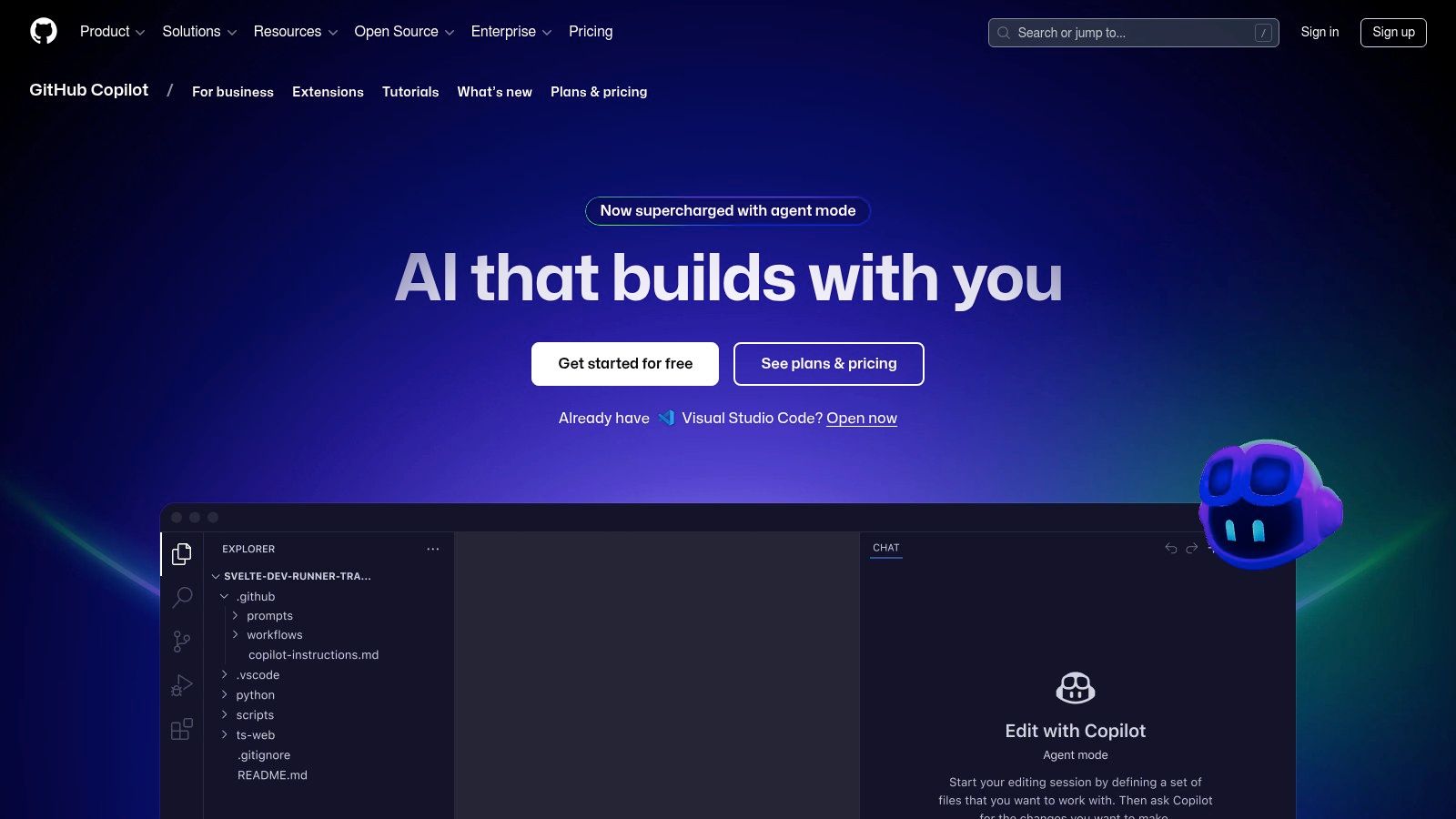
Copilot's strength lies in its ability to understand your coding intentions and provide intelligent suggestions. From auto-completing variable names and function calls to generating boilerplate code and offering multiple solutions to complex problems, Copilot significantly reduces the time spent on repetitive tasks. Imagine describing a function in plain English within a comment, and Copilot generates the code for you! This is particularly useful for tasks like writing unit tests, implementing standard algorithms, or tackling tricky syntax. For a deeper dive into its capabilities, learn more about GitHub Copilot. This makes it a standout choice among the growing number of ai tools for coding available today.
Key features that make GitHub Copilot an essential tool for any developer include:
- Real-time code suggestions: Copilot offers suggestions as you type, based on your comments and the surrounding code. This helps maintain coding flow and reduces interruptions.
- Multilingual support: Copilot supports a wide range of programming languages, ensuring flexibility and utility across different projects.
- IDE integration: Seamless integration with popular IDEs like VS Code and JetBrains makes it easy to incorporate Copilot into existing workflows.
- Function generation: Describe what you want a function to do in natural language, and Copilot will generate the code for you, accelerating development.
- Contextual understanding: Copilot understands your codebase, enabling it to provide relevant and accurate suggestions.
Pros:
- Increased coding speed: Drastically reduces time spent on boilerplate and repetitive code.
- Improved accuracy: Helps avoid syntax errors and ensures consistent code style.
- Continuous learning: Copilot continuously learns and improves its suggestions based on user interactions and codebases.
- Problem-solving assistance: Can suggest solutions to complex programming problems, saving valuable development time.
Cons:
- Cost: GitHub Copilot is a subscription-based service, priced at $10/month for individuals and $19/user/month for businesses.
- Potential inaccuracies: While constantly improving, Copilot can sometimes suggest incorrect or even insecure code, requiring careful review.
- Limitations with newer technologies: May not be as effective with very new or niche programming languages and frameworks.
- Privacy considerations: Code snippets are sent to OpenAI servers, raising potential privacy concerns for some users.
Website: https://github.com/features/copilot
Despite the subscription cost and the need for careful review of its suggestions, GitHub Copilot's powerful features and ability to drastically increase coding efficiency firmly establish its position as a leading ai tool for coding. It empowers developers to focus on the bigger picture—the logic and architecture of their projects—rather than getting bogged down in the minutiae of syntax and repetitive code.
Get started with your lifetime license
Enjoy unlimited conversations with MultitaskAI and unlock the full potential of cutting-edge language models—all with a one-time lifetime license.
Demo
Free
Try the full MultitaskAI experience with all features unlocked. Perfect for testing before you buy.
- Full feature access
- All AI model integrations
- Split-screen multitasking
- File uploads and parsing
- Custom agents and prompts
- Data is not saved between sessions
Lifetime License
Most Popular€99€149
One-time purchase for unlimited access, lifetime updates, and complete data control.
- Everything in Free
- Data persistence across sessions
- MultitaskAI Cloud sync
- Cross-device synchronization
- 5 device activations
- Lifetime updates
- Self-hosting option
- Priority support
Loved by users worldwide
See what our community says about their MultitaskAI experience.
Finally found a ChatGPT alternative that actually respects my privacy. The split-screen feature is a game changer for comparing models.
Sarah
Been using this for months now. The fact that I only pay for what I use through my own API keys saves me so much money compared to subscriptions.
Marcus
The offline support is incredible. I can work on my AI projects even when my internet is spotty. Pure genius.
Elena
Love how I can upload files and create custom agents. Makes my workflow so much more efficient than basic chat interfaces.
David
Self-hosting this was easier than I expected. Now I have complete control over my data and conversations.
Rachel
The background processing feature lets me work on multiple conversations at once. No more waiting around for responses.
Alex
Switched from ChatGPT Plus and haven't looked back. This gives me access to all the same models with way more features.
Maya
Finally found a ChatGPT alternative that actually respects my privacy. The split-screen feature is a game changer for comparing models.
Sarah
Been using this for months now. The fact that I only pay for what I use through my own API keys saves me so much money compared to subscriptions.
Marcus
The offline support is incredible. I can work on my AI projects even when my internet is spotty. Pure genius.
Elena
Love how I can upload files and create custom agents. Makes my workflow so much more efficient than basic chat interfaces.
David
Self-hosting this was easier than I expected. Now I have complete control over my data and conversations.
Rachel
The background processing feature lets me work on multiple conversations at once. No more waiting around for responses.
Alex
Switched from ChatGPT Plus and haven't looked back. This gives me access to all the same models with way more features.
Maya
Finally found a ChatGPT alternative that actually respects my privacy. The split-screen feature is a game changer for comparing models.
Sarah
Been using this for months now. The fact that I only pay for what I use through my own API keys saves me so much money compared to subscriptions.
Marcus
The offline support is incredible. I can work on my AI projects even when my internet is spotty. Pure genius.
Elena
Love how I can upload files and create custom agents. Makes my workflow so much more efficient than basic chat interfaces.
David
Self-hosting this was easier than I expected. Now I have complete control over my data and conversations.
Rachel
The background processing feature lets me work on multiple conversations at once. No more waiting around for responses.
Alex
Switched from ChatGPT Plus and haven't looked back. This gives me access to all the same models with way more features.
Maya
Finally found a ChatGPT alternative that actually respects my privacy. The split-screen feature is a game changer for comparing models.
Sarah
Been using this for months now. The fact that I only pay for what I use through my own API keys saves me so much money compared to subscriptions.
Marcus
The offline support is incredible. I can work on my AI projects even when my internet is spotty. Pure genius.
Elena
Love how I can upload files and create custom agents. Makes my workflow so much more efficient than basic chat interfaces.
David
Self-hosting this was easier than I expected. Now I have complete control over my data and conversations.
Rachel
The background processing feature lets me work on multiple conversations at once. No more waiting around for responses.
Alex
Switched from ChatGPT Plus and haven't looked back. This gives me access to all the same models with way more features.
Maya
Switched from ChatGPT Plus and haven't looked back. This gives me access to all the same models with way more features.
Maya
The sync across devices works flawlessly. I can start a conversation on my laptop and continue on my phone seamlessly.
James
As a developer, having all my chats, files, and agents organized in one place has transformed how I work with AI.
Sofia
The lifetime license was such a smart purchase. No more monthly fees, just pure productivity.
Ryan
Queue requests feature is brilliant. I can line up my questions and let the AI work through them while I focus on other tasks.
Lisa
Having access to Claude, GPT-4, and Gemini all in one interface is exactly what I needed for my research.
Mohamed
The file parsing capabilities saved me hours of work. Just drag and drop documents and the AI understands everything.
Emma
Switched from ChatGPT Plus and haven't looked back. This gives me access to all the same models with way more features.
Maya
The sync across devices works flawlessly. I can start a conversation on my laptop and continue on my phone seamlessly.
James
As a developer, having all my chats, files, and agents organized in one place has transformed how I work with AI.
Sofia
The lifetime license was such a smart purchase. No more monthly fees, just pure productivity.
Ryan
Queue requests feature is brilliant. I can line up my questions and let the AI work through them while I focus on other tasks.
Lisa
Having access to Claude, GPT-4, and Gemini all in one interface is exactly what I needed for my research.
Mohamed
The file parsing capabilities saved me hours of work. Just drag and drop documents and the AI understands everything.
Emma
Switched from ChatGPT Plus and haven't looked back. This gives me access to all the same models with way more features.
Maya
The sync across devices works flawlessly. I can start a conversation on my laptop and continue on my phone seamlessly.
James
As a developer, having all my chats, files, and agents organized in one place has transformed how I work with AI.
Sofia
The lifetime license was such a smart purchase. No more monthly fees, just pure productivity.
Ryan
Queue requests feature is brilliant. I can line up my questions and let the AI work through them while I focus on other tasks.
Lisa
Having access to Claude, GPT-4, and Gemini all in one interface is exactly what I needed for my research.
Mohamed
The file parsing capabilities saved me hours of work. Just drag and drop documents and the AI understands everything.
Emma
Switched from ChatGPT Plus and haven't looked back. This gives me access to all the same models with way more features.
Maya
The sync across devices works flawlessly. I can start a conversation on my laptop and continue on my phone seamlessly.
James
As a developer, having all my chats, files, and agents organized in one place has transformed how I work with AI.
Sofia
The lifetime license was such a smart purchase. No more monthly fees, just pure productivity.
Ryan
Queue requests feature is brilliant. I can line up my questions and let the AI work through them while I focus on other tasks.
Lisa
Having access to Claude, GPT-4, and Gemini all in one interface is exactly what I needed for my research.
Mohamed
The file parsing capabilities saved me hours of work. Just drag and drop documents and the AI understands everything.
Emma
The file parsing capabilities saved me hours of work. Just drag and drop documents and the AI understands everything.
Emma
Dark mode, keyboard shortcuts, and the clean interface make this a joy to use daily.
Carlos
Fork conversations feature is perfect for exploring different ideas without losing my original train of thought.
Aisha
The custom agents with specific instructions have made my content creation process so much more streamlined.
Thomas
Best investment I've made for my AI workflow. The features here put other chat interfaces to shame.
Zoe
Privacy-first approach was exactly what I was looking for. My data stays mine.
Igor
The PWA works perfectly on mobile. I can access all my conversations even when I'm offline.
Priya
Support team is amazing. Quick responses and they actually listen to user feedback for improvements.
Nathan
The file parsing capabilities saved me hours of work. Just drag and drop documents and the AI understands everything.
Emma
Dark mode, keyboard shortcuts, and the clean interface make this a joy to use daily.
Carlos
Fork conversations feature is perfect for exploring different ideas without losing my original train of thought.
Aisha
The custom agents with specific instructions have made my content creation process so much more streamlined.
Thomas
Best investment I've made for my AI workflow. The features here put other chat interfaces to shame.
Zoe
Privacy-first approach was exactly what I was looking for. My data stays mine.
Igor
The PWA works perfectly on mobile. I can access all my conversations even when I'm offline.
Priya
Support team is amazing. Quick responses and they actually listen to user feedback for improvements.
Nathan
The file parsing capabilities saved me hours of work. Just drag and drop documents and the AI understands everything.
Emma
Dark mode, keyboard shortcuts, and the clean interface make this a joy to use daily.
Carlos
Fork conversations feature is perfect for exploring different ideas without losing my original train of thought.
Aisha
The custom agents with specific instructions have made my content creation process so much more streamlined.
Thomas
Best investment I've made for my AI workflow. The features here put other chat interfaces to shame.
Zoe
Privacy-first approach was exactly what I was looking for. My data stays mine.
Igor
The PWA works perfectly on mobile. I can access all my conversations even when I'm offline.
Priya
Support team is amazing. Quick responses and they actually listen to user feedback for improvements.
Nathan
The file parsing capabilities saved me hours of work. Just drag and drop documents and the AI understands everything.
Emma
Dark mode, keyboard shortcuts, and the clean interface make this a joy to use daily.
Carlos
Fork conversations feature is perfect for exploring different ideas without losing my original train of thought.
Aisha
The custom agents with specific instructions have made my content creation process so much more streamlined.
Thomas
Best investment I've made for my AI workflow. The features here put other chat interfaces to shame.
Zoe
Privacy-first approach was exactly what I was looking for. My data stays mine.
Igor
The PWA works perfectly on mobile. I can access all my conversations even when I'm offline.
Priya
Support team is amazing. Quick responses and they actually listen to user feedback for improvements.
Nathan
2. Amazon CodeWhisperer
Amazon CodeWhisperer is a powerful AI coding assistant developed by AWS to help developers boost their productivity by generating code suggestions in real-time. Trained on a massive dataset of billions of lines of code, CodeWhisperer understands your coding context and even natural language comments to suggest relevant code snippets. This makes it a valuable tool for both seasoned developers and those just starting their coding journey. It supports a variety of popular programming languages like Python, Java, JavaScript, TypeScript, C#, and more, integrating seamlessly with popular IDEs such as VS Code, JetBrains IDEs, AWS Cloud9, and AWS Lambda. This broad compatibility makes it a versatile tool for various development environments and project types.

Imagine you're building a serverless application with AWS Lambda using Python. You need to write a function to interact with an S3 bucket. Instead of searching through documentation or Stack Overflow, you can simply write a comment like # Function to list all objects in my S3 bucket and CodeWhisperer will generate the necessary Python code, including the correct AWS SDK calls. This streamlines the development process, letting you focus on the bigger picture rather than the nitty-gritty details. This is particularly helpful when working with AWS services, as CodeWhisperer’s training allows it to offer AWS-specific solutions readily.
For those concerned about security, CodeWhisperer has built-in security scanning that helps identify potential vulnerabilities in your code as you write it. This proactive approach to security is a significant advantage, especially for developers working on sensitive projects. Furthermore, the reference tracking feature provides transparency by identifying the open-source projects that influenced a particular suggestion. This allows developers to understand the context and licensing implications of the generated code. You can learn more about Amazon CodeWhisperer and its advanced features.
CodeWhisperer offers a free tier for individual developers, making it accessible for experimentation and personal projects. However, commercial use requires a paid Professional tier subscription. While the free tier is a significant advantage for many, the potential reliance on AWS-specific solutions might be a drawback for some developers. Also, while rapidly maturing, it might not be as feature-rich as some of its more established competitors. Furthermore, its functionality is tied to the supported IDEs and environments, which could limit its usability in certain workflows.
Key Features and Benefits:
- Real-time code generation: Accelerate coding by generating code from comments and function signatures.
- Security scanning: Identify potential vulnerabilities early in the development process.
- Reference tracking: Understand the origins of suggested code and ensure proper attribution.
- Multi-language support: Supports a wide range of programming languages including Python, Java, JavaScript, TypeScript, C#, and more.
- IDE integration: Works seamlessly with VS Code, JetBrains IDEs, AWS Cloud9, and AWS Lambda.
Pros:
- Free tier for individual use.
- Robust security features with built-in vulnerability scanning.
- Strong integration with AWS services.
- Transparent code source tracking.
Cons:
- Paid Professional tier for commercial use.
- May prioritize AWS-specific solutions.
- Relatively newer compared to some competing AI coding tools.
- Limited to supported IDEs and environments.
Website: https://aws.amazon.com/codewhisperer/
Amazon CodeWhisperer earns its place on this list of AI tools for coding due to its potent combination of real-time code generation, robust security features, and seamless integration with the AWS ecosystem. Its free tier accessibility makes it an excellent choice for individual developers, while the Professional tier caters to commercial needs. While there are some limitations, the continuous development and improvements by AWS make CodeWhisperer a compelling choice for developers looking to enhance their coding efficiency and leverage the power of AI.
3. Tabnine
Boost your coding productivity with Tabnine, an AI-powered code completion tool leveraging deep learning to help developers write code faster and with fewer errors. This intelligent tool anticipates your needs by providing contextually relevant suggestions, completing lines of code, and even suggesting entire functions. Whether you're working on a personal project or collaborating with a team, Tabnine integrates seamlessly into your workflow, making it an invaluable asset for any developer seeking to enhance their coding efficiency. It supports a wide range of programming languages, ensuring versatility across various projects.
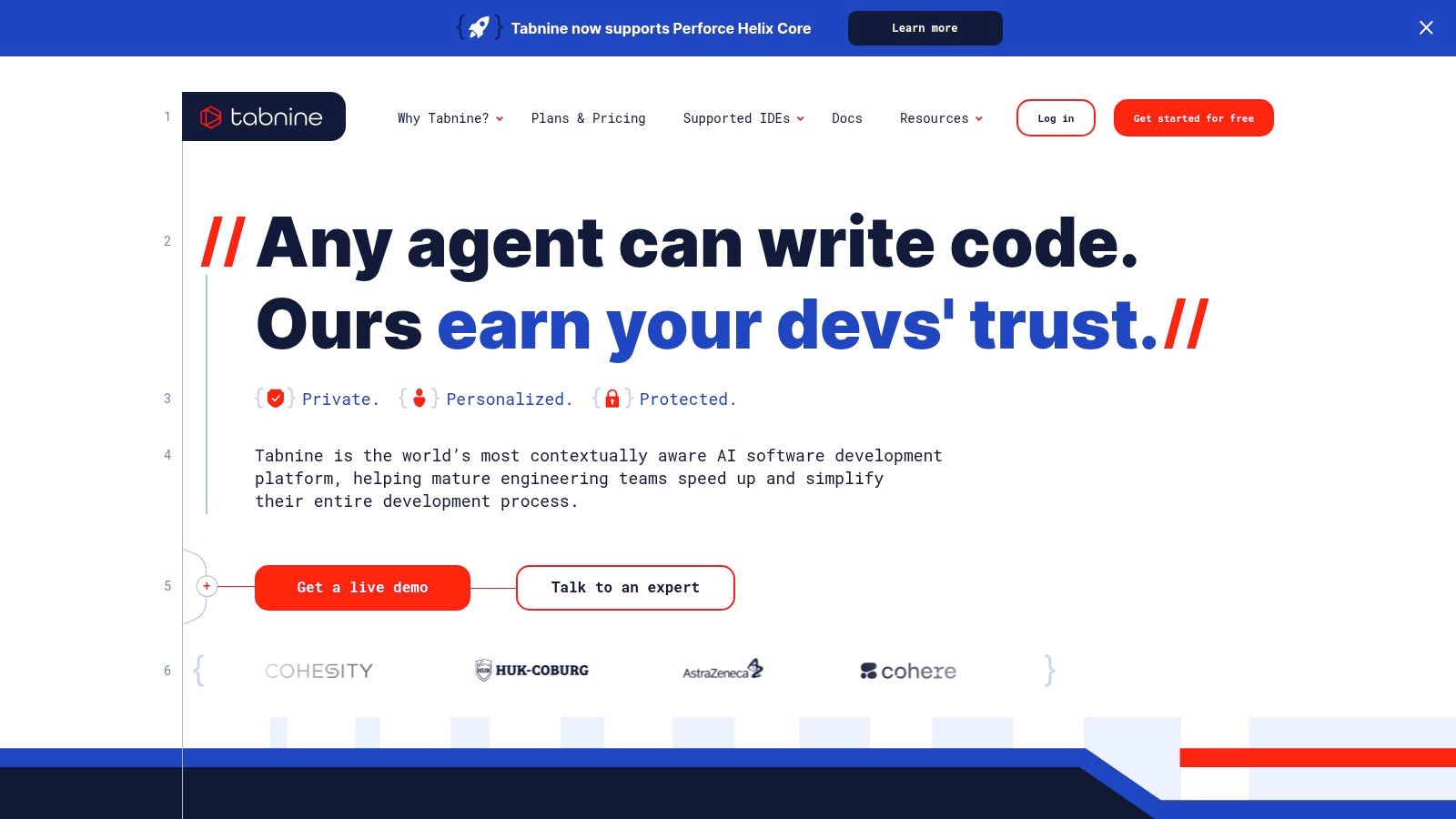
Tabnine's strength lies in its adaptive learning capabilities. It learns from your coding patterns and the collective knowledge of your team, if applicable, to provide increasingly accurate and relevant suggestions. This personalized approach sets it apart from other AI tools for coding that rely on more generic datasets. The availability of both cloud-based and local AI models offers flexibility and choice regarding privacy. The local model ensures sensitive code remains on your machine, addressing security concerns for those working on proprietary projects.
Tabnine deserves its place on this list because it effectively addresses a common developer pain point: writing repetitive boilerplate code. By predicting what you're likely to type next, Tabnine allows you to focus on the logic and architecture of your code, significantly speeding up development. Its support for over 30 programming languages, including popular choices like Python, JavaScript, Java, C++, and more, makes it a versatile tool for a wide range of projects.
Features and Benefits:
- AI-powered code completions for 30+ languages: Write code faster with intelligent suggestions across a diverse set of programming languages.
- Team learning: Standardize coding practices and share knowledge across your team, fostering consistency and efficiency.
- Local AI option: Enhanced privacy and security for sensitive projects by keeping your code on your machine.
- IDE integration: Supports most popular IDEs like VS Code, IntelliJ, and others, ensuring seamless integration into your existing workflow.
- Full-line and full-function completion: Predicts not just individual words but entire lines and even functions, significantly reducing typing effort.
Pros:
- Free tier available: Explore the basic functionality of Tabnine without any upfront cost.
- Local AI preserves privacy: Maintain complete control over your code and data.
- Adaptive learning: Personalized suggestions based on your individual and team's coding style.
- Lightweight: Minimal impact on IDE performance, ensuring a smooth coding experience.
Cons:
- Pro features require a paid subscription: Advanced features like team learning and more powerful AI models require a subscription.
- Local AI model has limitations: The local AI model, while prioritizing privacy, may offer less comprehensive suggestions compared to the cloud version.
- Learning curve: It may take some time for the AI to learn your coding patterns effectively.
- Occasional irrelevant suggestions: While generally accurate, the AI may occasionally provide irrelevant suggestions that require manual filtering.
Implementation and Setup Tips:
Installation is typically straightforward, involving downloading a plugin for your preferred IDE directly from Tabnine's website. After installation, you can configure the settings to choose between the cloud-based and local AI models based on your privacy preferences.
Comparison with Similar Tools:
While other code completion tools exist, Tabnine differentiates itself through its combination of AI-powered predictions, team learning capabilities, and the option for a local AI model. Competitors like Kite and GitHub Copilot offer similar functionality but may have different pricing structures or privacy considerations.
Pricing:
Tabnine offers a free tier with limited features and a Pro tier with enhanced functionality, including team training and access to more powerful AI models. Refer to the Tabnine website for the latest pricing information.
Website: https://www.tabnine.com/
Tabnine is a valuable addition to any developer's toolkit, offering a smart and efficient way to improve coding speed and accuracy. Its AI-powered suggestions, combined with the flexibility of local and cloud-based models, make it a compelling option for developers seeking to enhance their workflow.
4. Microsoft IntelliCode
Microsoft IntelliCode is a powerful AI tool for coding that seamlessly integrates with Visual Studio and Visual Studio Code, boosting developer productivity through intelligent code completions. Unlike basic IntelliSense, IntelliCode uses machine learning models trained on thousands of high-quality open-source GitHub repositories. This allows it to predict and suggest the most likely and relevant code completion based on the current context, your coding style, and even the conventions used in your specific codebase. This makes it a valuable asset for developers looking to streamline their workflow within the Microsoft ecosystem.

IntelliCode's star-based suggestion system highlights recommended API calls, making it easier to navigate complex libraries and frameworks. It learns your coding patterns and preferences over time, leading to more personalized and accurate suggestions. Support extends across various languages, including C#, C++, JavaScript/TypeScript, XAML, and Python, making it a versatile tool for diverse development projects. IntelliCode also infers code style and formatting preferences, helping teams maintain consistent coding standards throughout their projects. For example, if your team prefers a specific indentation style, IntelliCode will learn and suggest completions that adhere to that style. This is particularly useful in larger teams where maintaining code consistency is crucial.
Practical Applications and Use Cases:
- Rapid Prototyping: IntelliCode helps developers quickly build prototypes by suggesting common code snippets and patterns, accelerating the initial stages of development.
- Refactoring and Code Maintenance: IntelliCode assists with refactoring by offering relevant suggestions for renaming variables, extracting methods, and other common refactoring tasks. This leads to cleaner and more maintainable code.
- Onboarding New Team Members: New developers can quickly adapt to existing codebases and coding styles thanks to IntelliCode's context-aware suggestions, reducing the onboarding time.
- Learning New APIs and Libraries: IntelliCode's star-based recommendations make it easier to discover and utilize less familiar APIs and libraries, enhancing developer learning and exploration.
Comparison with Similar Tools:
While IntelliCode provides valuable assistance within the Microsoft ecosystem, it's important to note that newer AI coding assistants like GitHub Copilot and Tabnine offer more advanced features, such as generating entire code blocks and providing more comprehensive code suggestions. However, these often come with subscription fees. IntelliCode's free integration with Visual Studio and VS Code makes it a readily accessible option for developers already working within these environments.
Implementation and Setup Tips:
IntelliCode is generally automatically installed with recent versions of Visual Studio and VS Code. To ensure you have the latest version and features enabled, navigate to the extensions marketplace within your IDE and search for "IntelliCode." You can then install or update the extension as needed. No complex configuration is typically required, making it a simple tool to implement.
Pricing and Technical Requirements:
IntelliCode is free to use and is integrated directly into Visual Studio and Visual Studio Code. The technical requirements are minimal, simply requiring a compatible installation of Visual Studio or VS Code.
Pros:
- Free and integrated directly into Visual Studio and VS Code.
- Low learning curve for existing Microsoft IDE users.
- Improves productivity with contextual suggestions.
- Helps maintain coding standards consistently.
Cons:
- Less powerful than newer AI coding assistants like GitHub Copilot.
- Limited to Microsoft development environments.
- Focused primarily on IntelliSense improvements rather than generating complex code blocks.
- Personalized recommendations are more effective with a substantial existing codebase.
Website: https://visualstudio.microsoft.com/services/intellicode/
IntelliCode earns its place in this list by offering a readily accessible and practical solution for developers working within the Microsoft ecosystem. Its seamless integration with Visual Studio and VS Code, combined with its context-aware suggestions and free availability, make it a valuable tool for boosting productivity and code quality without a steep learning curve. While it may not possess the advanced capabilities of some newer AI coding assistants, it provides a solid foundation for AI-assisted coding within the familiar confines of Microsoft's popular IDEs.
No spam, no nonsense. Pinky promise.
5. Replit Ghostwriter
Replit Ghostwriter is a powerful AI pair programmer that lives right inside the Replit online IDE. This makes it a convenient choice for developers looking to integrate AI coding assistance seamlessly into their workflow. It offers a suite of features aimed at boosting productivity, including AI-powered code completion, generating code from natural language comments, debugging support, and even a chat interface for getting help with coding questions. This AI tool for coding empowers developers of all skill levels to write code faster and more efficiently, all without having to leave their coding environment.
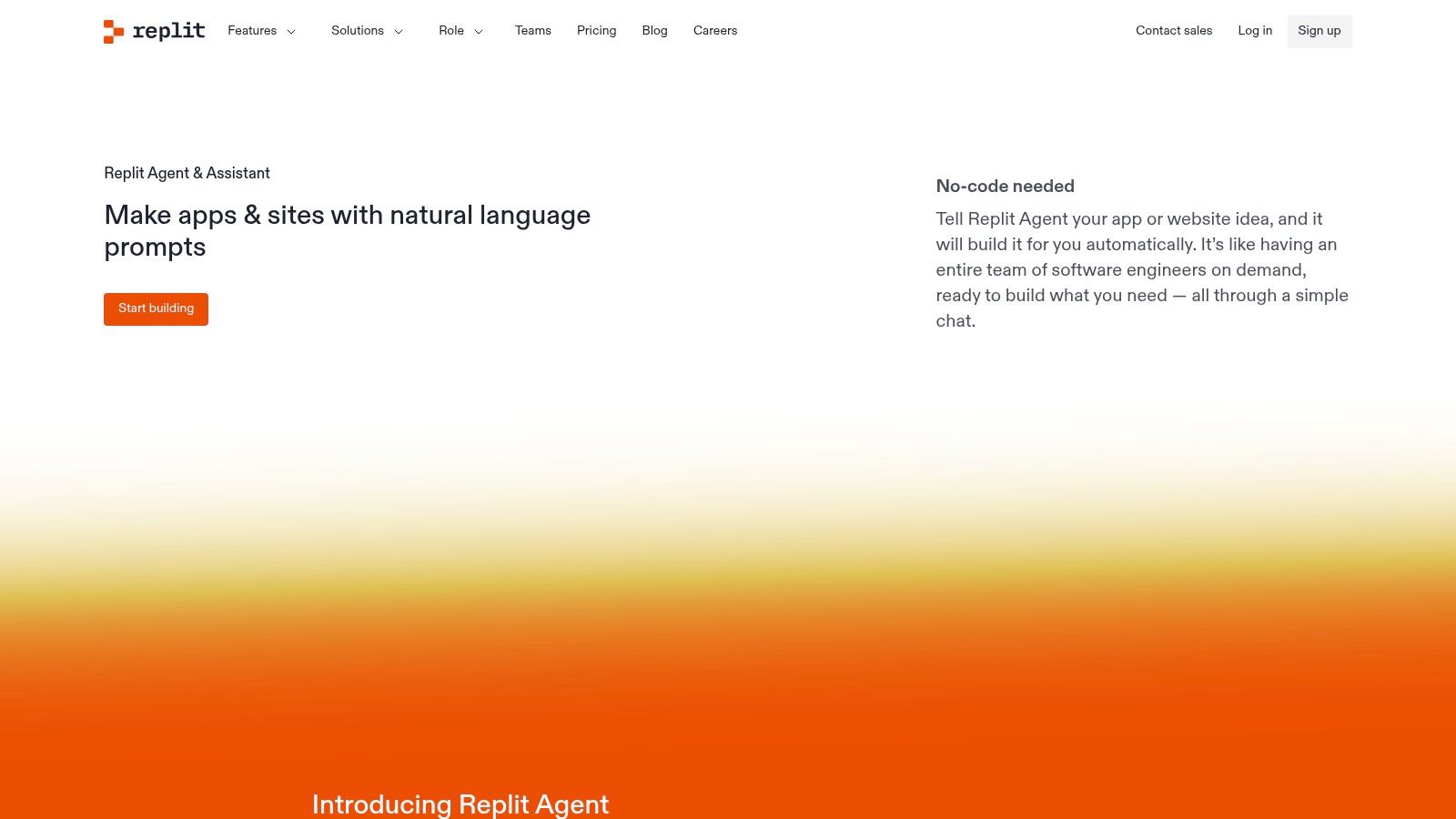
Replit Ghostwriter earns its place on this list of AI tools for coding because of its tight integration with the popular Replit platform. This eliminates the need for context switching between different applications and streamlines the development process. Imagine being able to generate an entire function just by describing what it should do in plain English, then immediately testing and tweaking it within the same environment. That's the power of Ghostwriter.
For instance, if you're working on a web application within Replit and need to implement a sorting algorithm, you can simply type a comment like "//Sort this array in ascending order" and Ghostwriter can generate the necessary code snippet for you. The built-in chat interface allows you to ask coding-related questions, clarify doubts, and even request code transformations in a conversational manner. This is particularly helpful for beginners who might be intimidated by more complex coding tools. More experienced developers can use Ghostwriter to speed up tedious tasks like writing boilerplate code or debugging tricky logic errors.
Key Features and Benefits:
- Context-Aware Code Completions: Ghostwriter goes beyond simple autocompletion by understanding the context of your code and suggesting relevant completions, making coding faster and reducing errors.
- Generate Code from Natural Language: Describe what you want your code to do in plain English, and Ghostwriter can generate the code for you.
- Integrated Chat for Coding Help: Ask coding questions, get explanations, and receive code suggestions directly within the IDE.
- Debugging Assistance: Get help identifying and fixing errors in your code.
- Seamless Replit Integration: Works directly within the Replit online IDE, eliminating the need for external tools.
Pros:
- No setup is required, making it incredibly easy to start using.
- The conversational interface is beginner-friendly.
- All coding tasks, from generation to debugging, can be handled within a single environment.
- Streamlines the development workflow for Replit users.
Cons:
- Requires a Replit subscription, starting at $10/month for individuals.
- Limited to the Replit environment.
- Might not be as feature-rich or performant as standalone AI coding assistants.
- Performance is tied to Replit's server availability.
Implementation/Setup Tips:
Since Replit Ghostwriter is built directly into the Replit IDE, there’s virtually no setup required. Simply open a Replit project and you can start using Ghostwriter's features immediately.
Comparison with Similar Tools:
While tools like GitHub Copilot and Tabnine also offer AI-powered coding assistance, Replit Ghostwriter differentiates itself through its seamless integration with the Replit ecosystem. This integration allows for a smoother, more cohesive coding experience within the browser-based IDE.
Website: https://replit.com/site/ghostwriter
Replit Ghostwriter is an excellent example of how AI can be integrated into existing development environments to boost productivity. While the subscription requirement might be a barrier for some, the ease of use and tight Replit integration make it a valuable ai tool for coding, particularly for developers who already use the Replit platform.
6. Cursor: Your AI-Powered Coding Companion
Cursor is not just another code editor; it's an AI-first coding environment designed to supercharge your workflow. Built on the familiar foundation of VSCode, Cursor integrates advanced AI capabilities powered by GPT-4 directly into your coding experience. This means you can generate, edit, refactor, debug, and even understand complex code with the help of AI, all within a single, streamlined interface. This makes it a powerful addition to any developer's toolkit and a standout amongst other AI tools for coding.
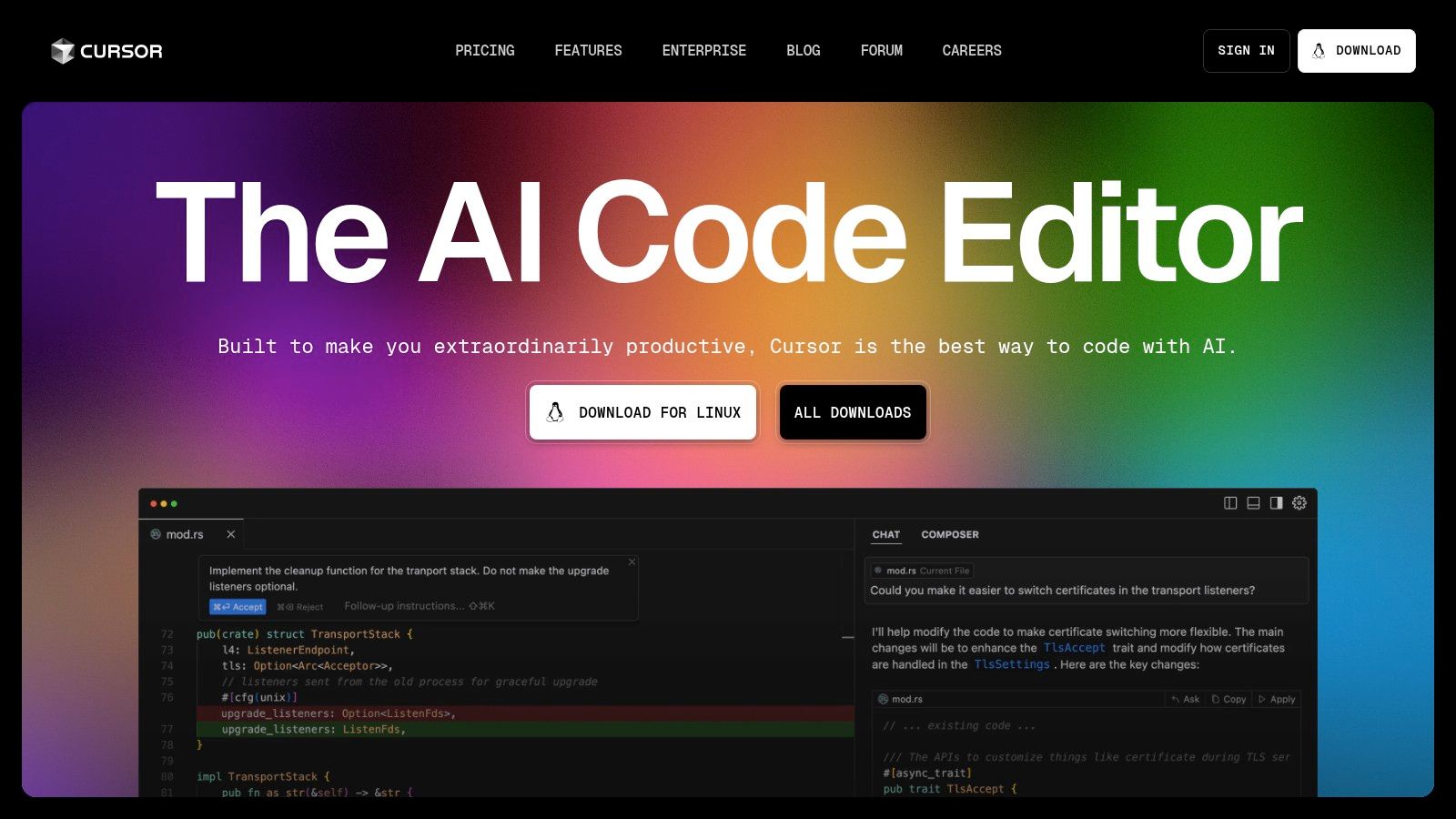
Imagine needing to refactor a complex function or struggling to understand a legacy codebase. Instead of spending hours poring over documentation or searching online forums, you can simply ask Cursor’s built-in AI chat. Provide natural language prompts to generate entire code blocks or edit existing ones. Need to track down a specific function? Cursor's smart code search leverages AI to quickly locate what you need. Even debugging becomes significantly easier with automated bug fixing and debugging assistance.
While other AI coding tools might offer similar functionalities, Cursor's deep integration with the coding environment makes it stand out. The ability to work with entire files and large contexts effectively, coupled with the power of GPT-4's understanding, allows for a more seamless and intuitive coding experience. This isn’t just about auto-completing lines of code; it’s about collaborating with AI to build and understand software more efficiently.
Features and Benefits:
- AI-Powered Code Generation: Generate code from natural language descriptions directly within the editor.
- AI-Assisted Editing: Modify and refactor code using natural language instructions.
- Smart Code Search: Quickly find specific functions and code snippets within your project.
- Automated Debugging: Receive AI-driven assistance with identifying and fixing bugs.
- Built-in AI Chat: Ask questions about your code and get instant answers.
- Familiar VSCode Interface: Leverage the benefits of a well-established and widely used code editor.
Pricing and Technical Requirements:
Cursor offers a free tier with access to GPT-3.5, though with usage limitations. For the full power of GPT-4 and additional features, the Pro tier is available for $20/month. As it’s built on VSCode, Cursor's technical requirements are similar to those of VSCode and should run on most systems, though the AI functionalities can be resource-intensive.
Pros and Cons:
Pros:
- Familiar VSCode interface with integrated AI capabilities.
- Powerful GPT-4 language model understanding (Pro tier).
- Effective handling of entire files and large contexts.
- Ability to explain complex code and suggest improvements.
Cons:
- Free tier limited to GPT-3.5 with usage caps.
- Pro tier ($20/month) required for GPT-4 and additional features.
- Relatively new product with potential stability issues.
- Can be resource-intensive on some systems.
Implementation and Setup Tips:
Download Cursor from the official website and install it like any other application. Familiarize yourself with the AI commands and shortcuts to maximize efficiency. Start by experimenting with simple tasks like code generation and editing before moving on to more complex functionalities.
Comparison with Similar Tools:
While tools like GitHub Copilot also offer AI-assisted coding features, Cursor differentiates itself through its deeper integration within a dedicated code editor. This creates a more streamlined workflow, making it easier to leverage AI throughout the entire coding process.
Why Cursor Deserves Its Place on the List:
Cursor represents a significant step forward in AI-powered coding. Its tight integration of powerful AI models with a familiar coding environment offers a truly enhanced coding experience. Whether you're a seasoned developer or just starting out, Cursor can boost your productivity and help you write better code, making it a valuable tool for anyone working with code.
Website: https://cursor.sh/
7. Codeium
Codeium is a powerful, free AI-powered code completion tool designed to significantly boost developer productivity. It helps you write code faster and more efficiently by offering context-aware suggestions, generating documentation, and even translating natural language into code. This makes it a valuable addition to any developer's toolkit, firmly earning its spot on this list of top AI tools for coding. With support for over 40 programming languages and integration with popular IDEs like VS Code, JetBrains, Vim, and Emacs, Codeium caters to a wide range of developers and coding styles.

One of Codeium's most compelling features is its ability to understand file context. This means the suggestions it provides are highly relevant to the code you're currently working on, reducing the time you spend sifting through irrelevant completions. Imagine working on a complex Python project; Codeium can analyze your existing code and provide intelligent suggestions that align with your project’s logic. It also supports natural language to code translation. For example, you could describe a function you need in plain English, and Codeium can generate the corresponding code snippet, saving you significant time and effort. This feature is particularly useful for repetitive tasks or when tackling unfamiliar syntax. Beyond individual developers, Codeium offers enterprise-grade solutions with additional features like self-hosting and enhanced security, though these require a paid subscription.
For developers looking to streamline their workflow, Codeium’s automatic code documentation generation is another valuable asset. It can automatically create documentation for your code, ensuring your projects remain well-documented and easy to understand, both for yourself and collaborators. This feature reduces the often tedious task of manually writing documentation, allowing you to focus on the core coding tasks. Setting up Codeium is generally straightforward. You can download the appropriate plugin for your IDE or editor and begin using it almost immediately. For basic functionality, you don’t even need an account, allowing for a frictionless initial experience.
Compared to other AI coding assistants like GitHub Copilot or Tabnine, Codeium stands out with its generous free tier offering unlimited code completions for individual use. This makes it an accessible option for hobbyists, students, and individual developers. While Copilot and Tabnine also offer powerful features, their free tiers are often more limited.
Pros:
- Free for individual use: Unlimited code completions without cost.
- No account required (basic functionality): Start coding immediately.
- Low latency response times: Quick and efficient suggestions.
- Privacy-focused: Safe handling of code data.
Cons:
- Enterprise features require paid subscriptions: Advanced functionalities come at a cost.
- Newer and less established than some competitors: May lack some features of more mature tools.
- Some advanced features still in development: The platform is still evolving.
- Quality can vary by programming language: Support and accuracy may differ based on the language used.
Website: https://codeium.com/
Codeium offers a compelling combination of powerful features and accessibility, making it a worthy contender in the space of AI tools for coding. Its free tier provides a great entry point for developers of all levels to experience the benefits of AI-powered code completion. While it is a relatively new tool, its rapid development and focus on user privacy position it as one to watch in the rapidly evolving landscape of AI-driven coding assistance.
8. Codiga
Codiga is an AI-powered code analysis platform designed to help developers write better code, faster. It goes beyond simple code completion by offering a suite of features including smart code snippets, automated code reviews, and robust quality checks, all within a single platform. This makes it a valuable ai tool for coding, especially for teams focused on maintaining high code quality and consistency. Codiga scans your code in real-time, identifying potential issues, enforcing coding best practices, and even suggesting ready-to-use code snippets that adhere to industry standards. This proactive approach helps prevent bugs early in the development process and promotes cleaner, more maintainable code.
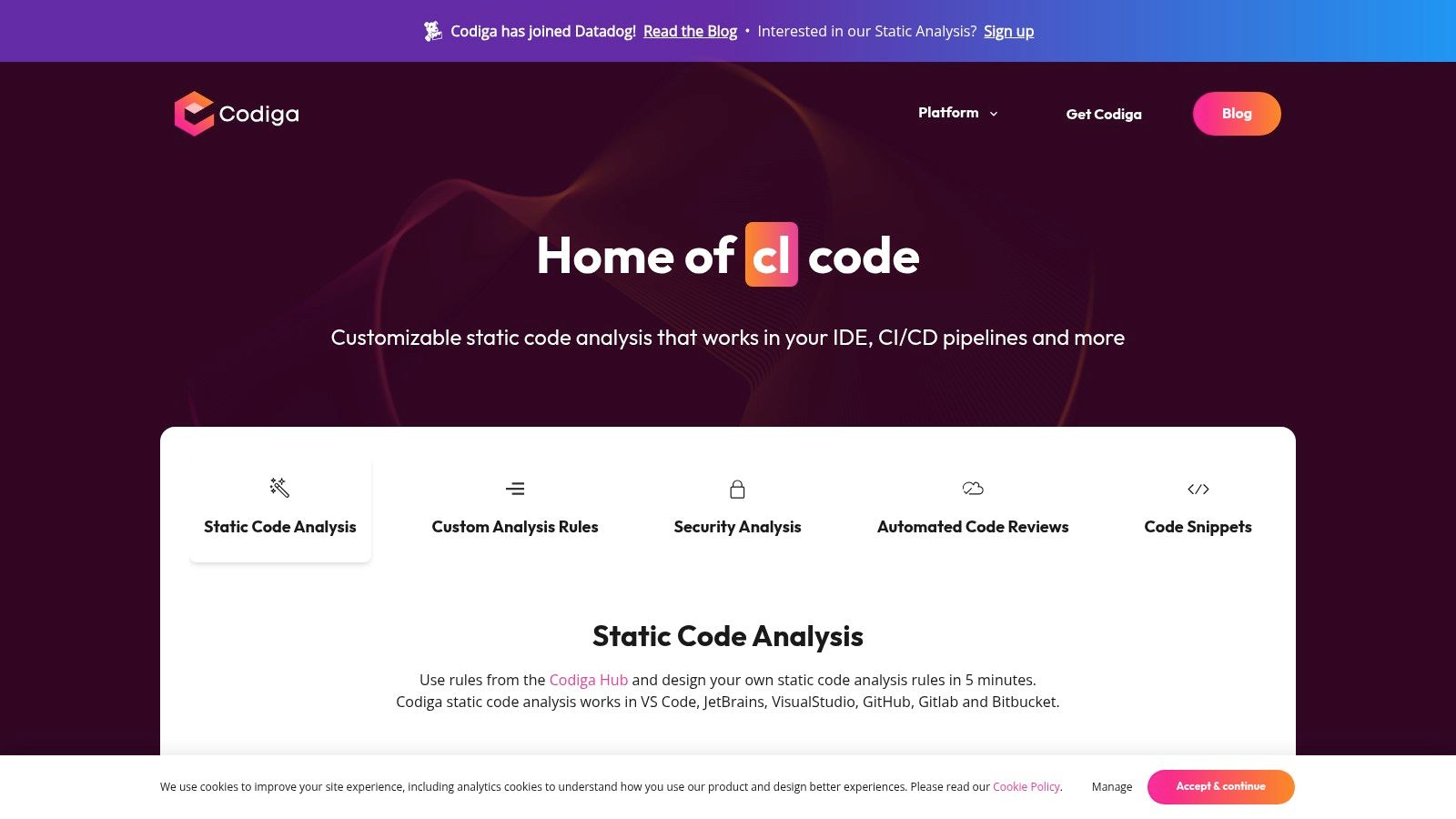
One of Codiga's standout features is its AI-powered code snippet library. Need to implement a specific function or algorithm? Codiga can often provide a pre-built, tested snippet that you can quickly insert into your code, saving you valuable time and effort. This is particularly helpful for repetitive tasks or when working with unfamiliar libraries or frameworks. Furthermore, Codiga allows you to create and share your own code recipes within your team, fostering collaboration and ensuring consistency across projects. This "shareable code recipe" system helps build a knowledge base of best practices and reduces the time spent reinventing the wheel for common coding tasks.
Unlike some other AI coding tools that primarily focus on code generation, Codiga emphasizes code quality and maintainability. Its automated code reviews and quality checks help identify potential bugs, security vulnerabilities, and style inconsistencies before they become major problems. You can even customize the coding rules and standards to match your team's specific requirements. This focus on quality makes Codiga a powerful tool for preventing technical debt and ensuring long-term project health.
Codiga integrates seamlessly with popular Git repositories like GitHub, GitLab, and Bitbucket, enabling automated code analysis as part of your CI/CD pipeline. This allows you to automatically enforce quality gates and prevent code with known issues from being merged into the main branch. This integration helps streamline the development workflow and ensures that code quality remains a top priority throughout the entire development lifecycle. Codiga supports over 12 programming languages including Python, JavaScript, and Java, making it a versatile tool for a wide range of projects.
Pricing and Technical Requirements:
Codiga offers a free tier with basic functionality, which is suitable for individual developers and small teams. For larger teams and enterprise-level features, a paid subscription is required. Specific pricing details are available on their website. Technical requirements are minimal as Codiga primarily operates as a cloud-based service, integrating directly with your existing development environment and repositories.
Comparison with Similar Tools:
While tools like GitHub Copilot and Tabnine focus heavily on generative AI for code completion, Codiga differentiates itself by prioritizing code analysis, quality, and maintainability. It's less about generating entirely new code and more about helping you write better, cleaner, and more consistent code.
Implementation and Setup Tips:
Getting started with Codiga is straightforward. Simply sign up for an account, connect your Git repositories, and install the relevant Codiga extension for your IDE. From there, you can start leveraging the platform's features for real-time code analysis, smart snippets, and automated code reviews. For advanced usage, explore Codiga's custom rule creation feature to tailor the analysis to your specific project needs.
Website: https://www.codiga.io/
Codiga earns its place on this list of AI tools for coding by offering a unique blend of AI-powered assistance and a strong emphasis on code quality. It's a valuable tool for developers and teams looking to improve their coding practices, reduce technical debt, and build better software. While it has a smaller community compared to some competitors and its enterprise features require a paid subscription, its focus on code quality and robust analysis capabilities make it a strong contender in the AI-powered coding tools landscape.
9. CodeT5: Your Open-Source AI Coding Companion
CodeT5 is a powerful, open-source AI tool specifically designed for code understanding and generation, making it a valuable asset for developers seeking to integrate AI into their workflows. Unlike commercial AI coding tools, CodeT5 offers complete control and flexibility, allowing you to build your own custom coding assistant or seamlessly weave it into your existing development environment. Its pre-training on a diverse range of programming languages equips it to handle tasks like code generation, translation between languages, code summarization, and even defect detection. This makes it a highly versatile tool for any developer working with AI tools for coding.
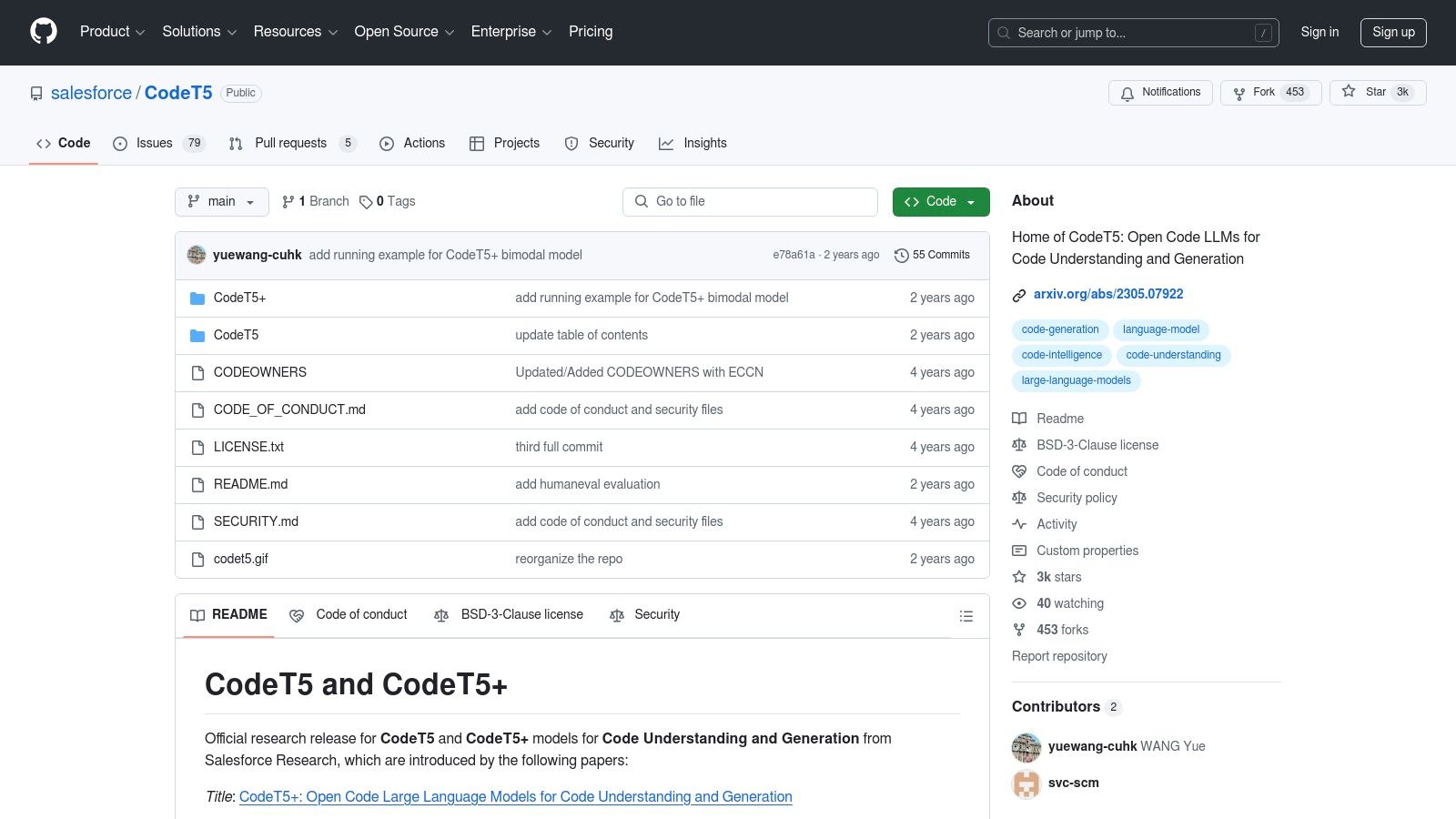
One of CodeT5's standout features is its open-source nature. This allows for complete customization and eliminates the usage restrictions or limitations often found with commercial alternatives. You can fine-tune it to specialize in specific coding tasks, tailor it to your particular domain or codebase, and even deploy it locally to maintain complete control over your data and privacy. For tech-savvy entrepreneurs, indie hackers, and those exploring the landscape of LLMs like ChatGPT, Anthropic, or Google Gemini, CodeT5 provides a playground for experimentation and innovation. For instance, you could integrate CodeT5 into your existing workflow to automate repetitive coding tasks, translate code between different languages within a project, or even build a customized code review assistant. If you are interested in exploring prompt engineering best practices to enhance your interactions with AI coding tools, learn more about CodeT5 and other powerful models.
While commercial AI coding assistants offer user-friendly interfaces and potentially greater raw power, CodeT5's strength lies in its flexibility and freedom. It empowers developers, AI professionals, and software engineers to build tailored solutions rather than relying on pre-packaged tools. Think of it as a powerful engine that you can customize and integrate into your own coding vehicle, rather than a ready-to-drive car.
Features:
- Open-source model for code understanding and generation
- Supports multiple programming languages
- Can be fine-tuned for specific coding tasks
- Handles code summarization and translation between languages
- Identifies potential bugs and suggests fixes
Pros:
- Completely free and open-source
- Can be deployed locally for full privacy
- Customizable for specific domains or codebases
- No usage restrictions or limitations
Cons:
- Requires technical expertise to implement
- No ready-to-use interface like commercial tools
- Needs significant computing resources for deployment
- Less powerful than the latest commercial models
Website: https://github.com/salesforce/CodeT5
CodeT5’s open-source nature, customizability, and focus on code make it a worthy addition to this list of AI tools for coding. It empowers developers with a level of control and flexibility unmatched by commercial alternatives, opening doors to unique applications and integrations within the coding workflow. While it demands more technical proficiency, the potential rewards are significant for those willing to invest the effort.
10. Kite
Kite is an open-source AI-powered coding assistant that was specifically designed to streamline Python and JavaScript development. While no longer actively updated since November 2021, Kite's local, AI-driven code completion engine remains a valuable tool for some developers, especially those prioritizing offline functionality and data privacy. Its focus on local processing eliminates the need for data transmission to external servers, a key consideration for developers working with sensitive codebases. Though superseded by newer AI coding tools, Kite offers a compelling free and offline alternative for Python and JavaScript coding. This positions Kite as a practical choice for developers who prioritize offline functionality and data privacy. If you're seeking AI assistance for coding without relying on cloud-based solutions, Kite might be a good fit.
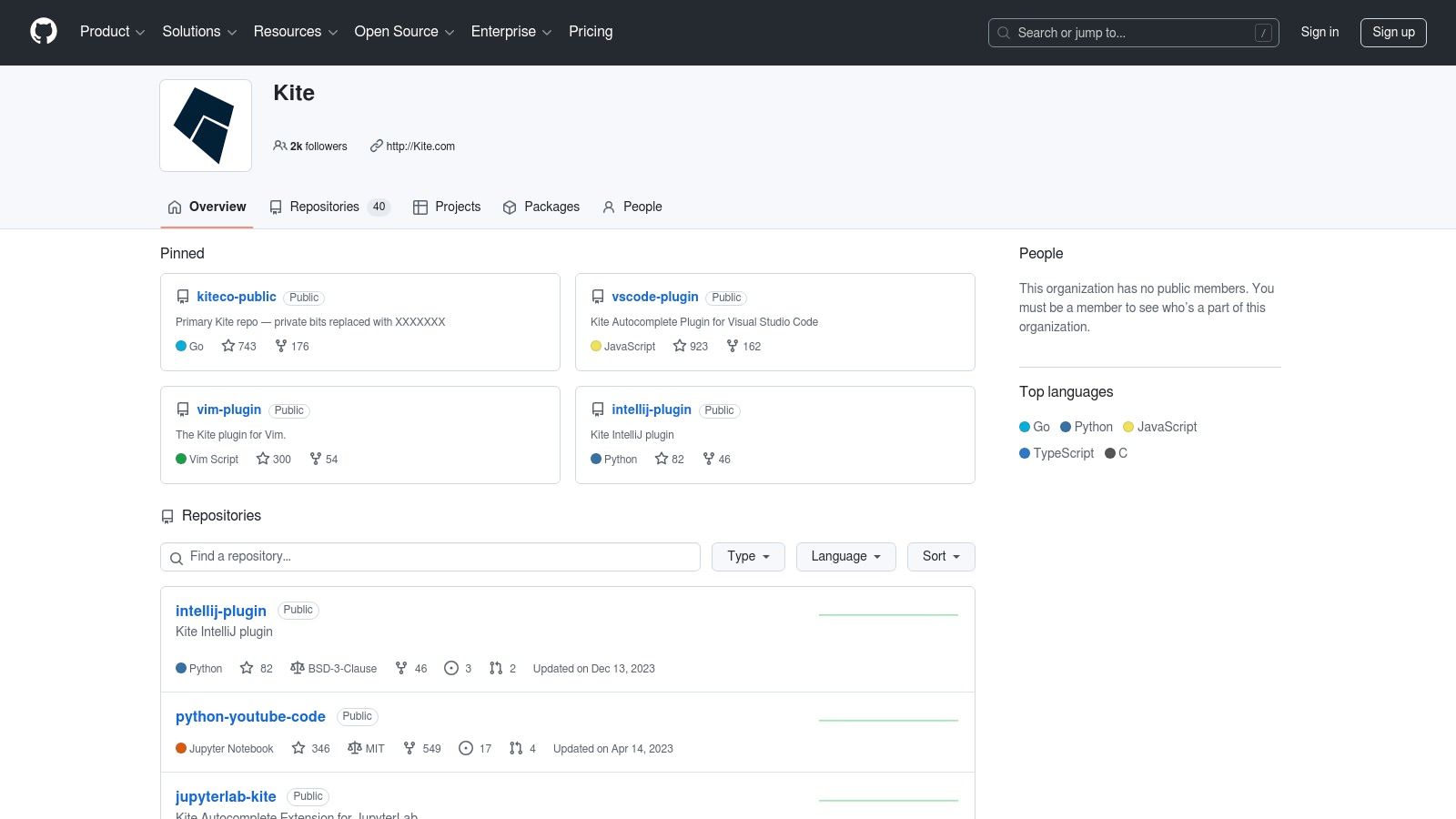
Kite's core strength lies in its AI-powered code completion engine. It goes beyond basic syntax completion, offering intelligent suggestions based on the context of your code. This includes predicting function signatures, displaying relevant documentation snippets, and providing line-of-code completions. This functionality can significantly speed up development, especially for tasks involving complex libraries or frameworks. While limited primarily to Python and JavaScript, Kite's offline availability sets it apart from cloud-based AI coding assistants. It integrates smoothly with a range of popular editors, such as VS Code, Atom, and various JetBrains IDEs.
Kite's demise leaves a gap for offline AI coding assistance, especially for Python and JavaScript. While newer cloud-based tools like GitHub Copilot and Tabnine offer more sophisticated features and broader language support, they require an active internet connection and often involve subscription fees. Kite's open-source nature and offline capability fill a unique niche for developers who value privacy, offline access, or prefer not to subscribe to another service.
Features:
- AI-powered code completions for Python and JavaScript
- Local processing for privacy and offline use
- Integration with VS Code, Atom, and JetBrains IDEs
- Function signatures and documentation display
- Intelligent line-of-code completions
Pros:
- Local processing keeps code private.
- Open-source components are still available.
- No subscription is required.
- Works offline once installed.
Cons:
- No longer actively developed or supported.
- Limited to Python and JavaScript primarily.
- Less advanced than current AI coding tools.
- Installation and setup can be more complex than cloud alternatives.
Website: https://github.com/kiteco
Despite being discontinued, Kite earns its spot on this list by catering to a specific need within the AI coding assistance landscape. While it may not be the most advanced or feature-rich option available, its focus on local processing, offline availability, and open-source nature provides a unique and still valuable alternative to cloud-based AI tools. For developers working primarily in Python or JavaScript and prioritizing privacy and offline access, Kite might still be a useful ai tool for coding.
Top 10 AI Coding Tools: Feature Comparison
| Product | Key Features ✨ | UX & Quality ★ | Pricing 💰 | Audience 👥 |
|---|---|---|---|---|
| GitHub Copilot | Real-time code suggestions; IDE integration | Intuitive & context-aware; occasional errors | Subscription ($10/mo individuals, $19/mo teams) | Developers seeking smart pair programming |
| Amazon CodeWhisperer | Code generation with security scanning | Secure, smooth AWS integration | Free tier for individuals; paid for commercial | AWS-focused and security-conscious developers |
| Tabnine | AI completions with local option | Lightweight, adaptive to team standards | Free basic tier; paid pro available | Privacy-focused teams and individual coders |
| Microsoft IntelliCode | Context-aware suggestions in Visual Studio/VS Code | Seamless for MS IDE users; consistent | Free | Developers in the Microsoft ecosystem |
| Replit Ghostwriter | Chat-based coding help and debugging assistance | Beginner-friendly, integrated in Replit | Included with Replit subscription (~$10/mo) | Browser-based and beginner developers |
| Cursor | VSCode-based with GPT-4 code generation | Familiar UI, advanced AI chat support | Free (GPT-3.5 limited) & Pro ($20/mo for GPT-4) | Advanced developers embracing GPT-4 technology |
| Codeium | 40+ language support; natural language to code | Fast, low latency, privacy focused | Free for individual use; enterprise paid options | Broad range of developers prioritizing speed |
| Codiga | Automated code reviews and quality checks | Improves code quality; review-centric | Free tier exists; enterprise pricing available | Teams emphasizing code standards and quality |
| CodeT5 | Open-source transformer for code understanding | Customizable but requires technical know-how | Free & self-hosted | Developers needing flexible, open-source solutions |
| Kite | Local code completions for Python/JavaScript | Offline, privacy-focused; limited scope | Free | Coders needing offline assistance with privacy |
Choosing Your Ideal AI Coding Companion
The world of AI coding tools is rapidly evolving, offering a diverse range of options for everyone from seasoned software engineers to budding indie hackers. This article explored ten powerful AI tools for coding, including GitHub Copilot, Amazon CodeWhisperer, Tabnine, Microsoft IntelliCode, Replit Ghostwriter, Cursor, Codeium, Codiga, CodeT5, and Kite. Each tool brings unique strengths to the table, from intelligent code completion (like Tabnine and IntelliCode) to powerful code generation capabilities (like GitHub Copilot and Replit Ghostwriter).
Key takeaways include the understanding that these AI tools for coding can significantly boost productivity by automating repetitive tasks, suggesting code snippets, and even helping debug existing code. They empower developers to focus on higher-level design and problem-solving, ultimately accelerating the development process.
To select the perfect AI coding companion, consider your specific needs. Do you primarily work in a specific language? How important is seamless IDE integration? Are robust privacy features a must-have? Some tools excel at generating entire functions from natural language prompts, while others focus on providing highly accurate code completion suggestions within your existing workflow.
When implementing these tools, remember that they are designed to augment, not replace, your coding skills. Use them to explore new approaches, learn new libraries, and speed up your workflow, but always review the generated code carefully to ensure accuracy and maintainability. The balance between code completion and code generation capabilities offered by different AI tools for coding should also factor into your decision-making process.
For developers looking to manage multiple AI models simultaneously, platforms like MultitaskAI offer an efficient and privacy-focused solution. This allows you to leverage the strengths of various AI coding assistants without juggling multiple interfaces.
Explore the tools discussed in this article, experiment with their features, and discover how the power of AI can transform your coding workflow in 2025 and beyond! The future of coding is here, and it's intelligent, efficient, and more accessible than ever.